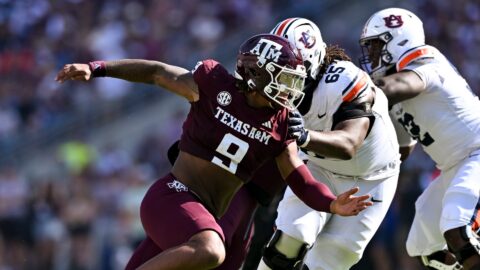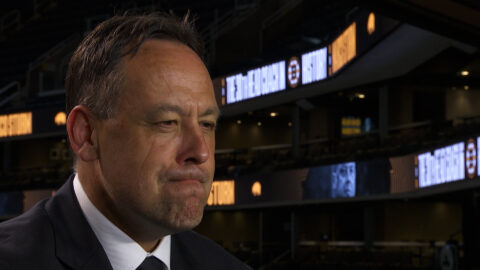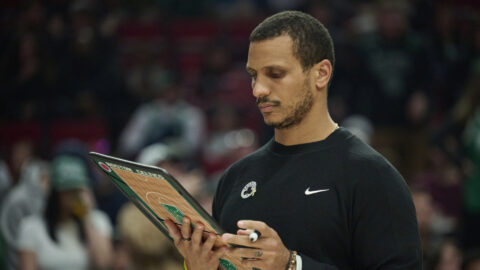The Red Sox can make all the big-name signings their wallet would allow, but it might not matter much if injuries incur their wrath, as they famously did in 2010. It especially won’t matter if some of the protection from such injuries, players at the Double- and Triple-A levels, is ill-prepared.
The Red Sox Rookie Program, an annual two-week session for a dozen or so minor leaguers on the cusp of being ready for the majors, is one factor in preparing players for when their name is called. As last year showed us all, those calls can come in rapid fashion.
"It’s hard to point back to this program and say this is a difference-maker in any way, shape or form, but you do feel like it has its benefits for those guys, not only going to camp for the first time or coming up during the year, to be a little better prepared," said director of player development Mike Hazen on Wednesday from the field at Boston College's Alumni Stadium, where the 11 participants in this year’s session were undergoing their daily workout.
"The speed of the game is still going to dictate and the anxieties are still going to be there, but if we can minimize those at all [through the rookie program] we’d be successful."
The program is designed to help players with a "12- to 18-month window to the big leagues" learn the ins and outs of major league life, Hazen said. In addition to workouts and meetings with coaches and team staff, the two weeks give the group a chance to learn other aspects off the field, including how to handle the media and the basics of community service.
Some guys, like Ryan Kalish last year, seem so unaffected by the bright lights. But some of that may have to do with him being an alumnus of the program. Its effects are impossible to measure, as many of the items involve such matters as finding one’s way to Fenway Park in traffic, but seeing Kalish do his job on and off the field last summer lends some support to the process.
"He’s the shining example, at least from last year, of going about it the right way and seeing those types of things pay off," Hazen said of Kalish, who was on hand with a few other major leaguers to take part in some of the workouts Wednesday morning. "It's not going to pay off for all these guys in the same time frame like it did with Ryan because hopefully we’re not going to go through the injury situation we went through last year.
"His name has been brought up quite a bit in this program, how you go about it the right way, how you assimilate. He didn’t come up here and hit .320 with 15 home runs. He came up and did his job. He played defense, he ran the bases. The impression that that made on the staff, these guys see that, and hopefully they will want to emulate it."
Among those hoping to emulate Kalish one day, perhaps in 2011, are six pitchers and five position players. The pitchers are: Robert Coello, Stephen Fife, Stolmy Pimentel, Jason Rice, Clevelan Santeliz and Alex Wilson. Catchers Ryan Lavarnway and Tim Federowicz are joined by second baseman Oscar Tejeda, third baseman Will Middlebrooks and outfielder Juan Carlos Linares, a 26-year-old Cuban defector who will be entering his first full season in the system.
Lavarnway is among the more promising of the bunch. The organizational Co-Offensive Player of the Year in 2010 hit 22 home runs and had 102 RBIs between Single-A Salem and Double-A Portland. He could be looking at a big league shot sooner than later and appreciates what he has taken from the program.
"It’s a little bit of finishing school for us off the field," Lavarnway said. "Little things like how do we get to the field, how do we get into the stadium and where's the locker room, so once we do get that call or the manager at Triple-A or Double-A calls us into the office and we can really think about how am I going to help the team win tomorrow night, who am I facing, what position am I going to play."
In addition to Kalish, many of the team's young stars are graduates of the session, including Clay Buchholz and Daniel Bard, two of the better adjusted 25- or 26-year-olds one would find league-wide.
The one player in this year's grouping who has seen major league action is Coello, a right-hander who appeared in six games for Boston late last season. Despite already having that experience in tow, he is seeing incredible value in getting a jump on spring training. He has also been a source of questioning for the other 10 guys wondering what it’s like to be in that Red Sox clubhouse.
"We’ve had some discussions. I've told them it's phenomenal," Coello said before discussing what the program will do for him and the others if their name is called in 2011. "It'll be a benefit. You'll know the routine and what your duties are."
Coello held opponents scoreless in five of the six appearances he made for the Red Sox. It is not a huge sample, but showed the organization that he might be a serviceable arm if one is needed in the big league bullpen.
Hazen said that having protection like that is a philosophy the organization has always had, but one that showed a few cracks last year. Not that Kalish and others did not perform well when called upon — quite the contrary — but some guys were plucked from the minors before it was ideal due to a lack of meaningful depth at a position or two, or they rode the shuttle back and forth multiple times like Josh Reddick. Steps have been taken through a handful of acquisitions, particularly relievers, to remedy that situation.
"All those minor league guys are signed for depth purposes, coming into spring training, to protect the major league club for injury or poor performance or whatever it may be," Hazen said. "We look to protect at every single position. You saw what happened last year. When we had those types of situations we obviously didn’t do a good enough job of having better players for the major league club. We need to do a better job in that area."
If some of those signings do not pan out, there are 11 guys who are more prepared to make the leap than they were two weeks ago. As 2010 taught us, having well-prepared minor leaguers is nearly as important as having a boatload of superstars.



